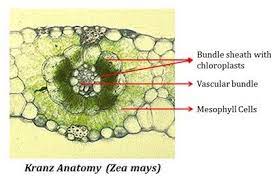Difference between C3, C4 & CAM Plants
To convert light energy into chemical energy, plants incorporated CO2 from atmosphere in the presence of light absorbed by chloroplast and water from soil. The reduction of carbon dioxide (called Dark Reaction) in the process of photosynthesis forms carbohydrates.
In hot & dry conditions, plants close their stomata to prevent water loss. Under these conditions, CO2 will decrease and oxygen gas, produced by the light reactions will increase, causing an increase of photorespiration by the oxygenase activity of ribulose-1,5-bisphosphate carboxylase/oxygenase and decrease in carbon fixation. Some plants have evolved mechanisms to increase the CO2 concentration in the leaves under these conditions.
Based on the method of reduction of carbon dioxide, plants are classified into C3, C4 & CAM plants.
C3 Plants
- C3 plants do not use PEP-carboxylase in carbon fixation because the primary carboxylation reaction, catalyzed by RuBisCO, produces the 3-carbon 3-phosphoglyceric acids directly in the Calvin-Benson cycle. Hence the initial product of carbon fixation is the three-carbon compound and the enzyme involved in the primary carboxylation is ribulose-1,5-bisphosphate carboxylase.
- Photo respiration is high in these plants.
- Examples of C3 plants are Rice, wheat, barley and soyabean.
- Over 90% of plants use C3 carbon fixation, compared to 3% that use C4 carbon fixation.
C4 Plants
- Plants that use the C4 carbon fixation process chemically fix CO2 in the mesophyll cell by adding it to the 3-carbon molecule called phosphoenolpyruvate (PEP) catalyzed by an enzyme called PEP carboxylase, creating the 4-carbon organic acid oxaloacetic acid. This enzyme has high affinity for carbon dioxide and capable of assimilating carbon dioxide even at a lower concentration.
- The physical separation of RuBisCO from the oxygen-generating light reactions reduces photorespiration and increases CO2fixation and, thus the photosynthetic capacity of the leaf.
- C4 Plants can produce more sugar than C3plants in conditions of high light and temperature.
- Examples of C4 plants are maize, sorghum, sugarcane, pearl millet and other minor millets.
- C4 minor millets, even under good management do not outyield C3 rice.
- The photosynthetic advantage of C4 plants compared with C3 plants at the level of carboxylation is reduced at the whole leaf level. It is due to combination of stomatal and mesophyll resistance at the leaf level and by mutual shading and periods of low light at a plant community level. As a result, no consistence advantage of the C4 pathway is evident in crop growth rates and crop yields of C4 plants.

Crassulacean acid metabolism (CAM)
- Xerophytes, such as cacti and most succulents, also use PEP carboxylase to capture CO2 in a process called Crassulacean acid metabolism (CAM).
- CAM plants have a different leaf anatomy from C3 plants, and fix the CO2 at night when their stomata are open.
- CAM plants store the CO2 mostly in the form of malic acid via carboxylation of phosphoenolpyruvate to oxaloacetate, which is then reduced to malate. Decarboxylation of malate during the day releases CO2 inside the leaves, thus allowing carbon fixation to 3-phosphoglycerate by RuBisCO.
- CAM is used by 16,000 species of plants.
Difference between C3, C4 & CAM Plants
C3 Plants C4 Plants CAM Plants Initial product of carbon fixation is the three-carbon compound named PGA (Phosphoglyceric Acid). Initial product of carbon fixation is the four-carbon compound which may be Maleic acid or Aspertic acid. In these plants, stomata are open at night and large amount of carbon dioxide is fixed as maleic acid which is stored in vacuoles. During day, stomata are closed hence there is no possibility of carbon dioxide. carbon dioxide is reduced as in the case of C3 plants. The enzyme involved in the primary carboxylation is ribulose-1,5-bisphosphate carboxylase. The enzyme involved in the primary carboxylation is phosphoenol pyruvic acid (PEP) carboxylase. - Photo respiration is high. Negligible. Transpiration is negligible. Low as compared to Photosynthetic rate higher. - Better adaption to cool temperature with only moderate insolation. Better adaption to higher temperature and higher insolation. - Lower water use efficiency. Higher water use efficiency. Higher water use efficiency. Examples: Rice, Soyabean, Wheat, Barley, Oat, Cotton, Groundnut, Sunflower, Rye, Potato, Tomato, Sweet potato, Sugar beet. Examples: Sorghum, Sugarcane, Maize, Pearl millet, Other minor millets. Examples: Pineapple, sisal.
Read…
Vascular and Non-Vascular Plants
Millets One Linear Notes